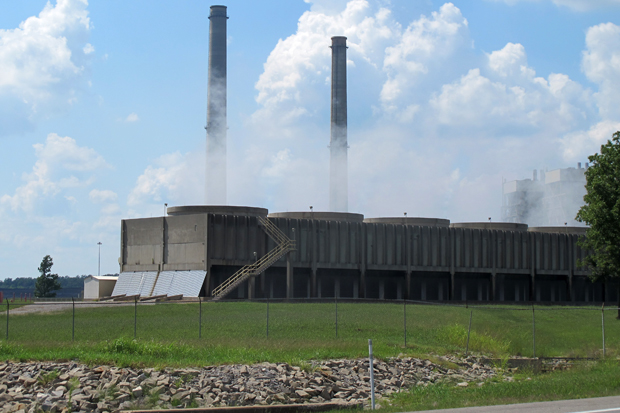
The Grand River Dam Authority's coal-fired plant in Chouteau, Okla.
Logan Layden / StateImpact Oklahoma


The Grand River Dam Authority's coal-fired plant in Chouteau, Okla.
Logan Layden / StateImpact Oklahoma

Logan Layden / StateImpact Oklahoma
The Grand River Dam Authority's coal-fired plant in Chouteau, Okla.
President Obama’s Clean Power Plan enraged many top officials in Oklahoma, who argued the rules were an expensive, unnecessary overreach by the federal government.
But the effort to reduce greenhouse gas emissions could create opportunities in Oklahoma, researchers and officials say.
President Obama on Aug. 3 met the press and his supporters in the East Room of the White House to formally debut his plan to fight global warming by cutting emissions from power plants — the most strident action by the federal government to fight climate change.
The plan has three parts. First, it reduces air pollution from existing power plants, which could force hundreds of coal-fired plants to close. Second, Obama wants even steeper emission limits on new power plants — a move that could make it nearly impossible to build a new coal plant in the United States.
The third part assigns every state a specific emission reduction goal and requires them to create a plan to meet it. The U.S. Environmental Protection Agency is giving states some flexibility in how they reduce air pollution from power plants, and Oklahoma’s electricity utilities are still digesting the implications of the complicated, lengthy plan.
If Oklahoma choses a rate-based approach, for example, it would have to cut greenhouse gas emissions by 32 percent — a pretty average rate compared to other states.
Oklahoma Republicans have vowed resistance. Gov. Mary Fallin in April issued an executive order prohibiting state agencies from developing a compliance plan.
Attorney General Scott Pruitt and his counterparts in 14 other states have already filed paperwork to fight Obama and the Clean Power Plan in court.
“When you look at fossil fuels, oil, natural gas and coal, it generates approximately 70 percent of all our energy,” Pruitt told Fox Business host Neil Cavuto.
“If you have this war on coal, that the EPA is engaged in, and you take 30 to 35 percent of that fossil fuel mix off the grid, what is that going to do? It’s going to cause rates to skyrocket across the country.”
Lanny Nickell, vice president of engineering for the Southwest Power Pool, the authority that oversees the grid and wholesale electricity market in Oklahoma and 13 other states, is hoping states — supposing the federal rules survive the legal challenge — will coordinate in writing their compliance plans.
“For the most part, the average citizen doesn’t understand the fact that electricity — and the way energy flows across the network — is not confined to state boundaries,” Nickell says.
About half the states in the SPP have joined the legal challenge against the Clean Power Plan.
To comply with Obama’s environmental plan, Nickell says many states in the SPP will likely have to get more of their power from renewables — sources like solar and wind. They could also use more natural gas, either by converting older coal plants to use the cleaner-burning fuel or by building new natural gas-fired plants.
Each state has a unique electricity mix — both in the amount of power they require and the sources fueling the power they generate, says Jonas Monast, who directs the climate energy program at Duke University’s Nicholas Institute for Energy Policy Solutions.
“We’ve never had a homogeneous electricity sector,” he says. “Some states have more wind, some states generate electricity using more natural gas, some states use more nuclear.”
Those differences could create an opportunity for industries in some states, including Oklahoma, Monast says.
States seeking “lower-carbon alternatives” for electricity generation, Monast says, “means demand for natural gas and renewable energy would very likely increase as a result of this rule.”
Oklahoma ranks fourth nationally in both wind power capacity and natural gas production, data from from the American Wind Energy Association and the U.S. Energy Information Administration show.
Monast says utilities, states and the power grids that connect them are facing a lot of electricity uncertainty. Demand and regulations are increasing. Wind and solar aren’t always reliable. The cost of fuel sources, like natural gas, is hard to predict. But Monast says Obama’s Clean Power Plan gives states the flexibility to use the market in their favor.
“This is now sending a market signal to the electricity sector putting it on a path for the next 10, 20 years and creating some investment certainty for utilities and for their shareholders so they can make more educated decisions about where to invest their money,” he says.